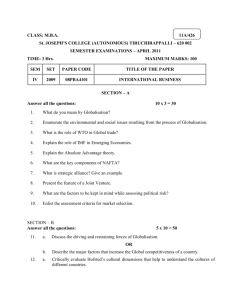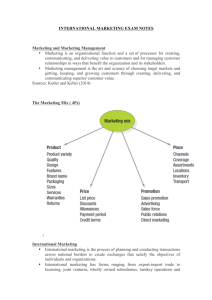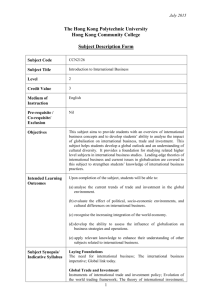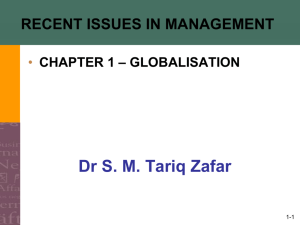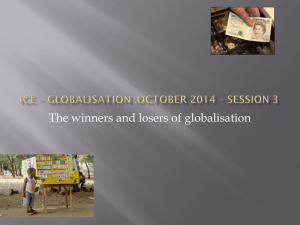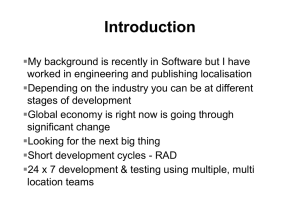MGX5181 week 1 2014
advertisement
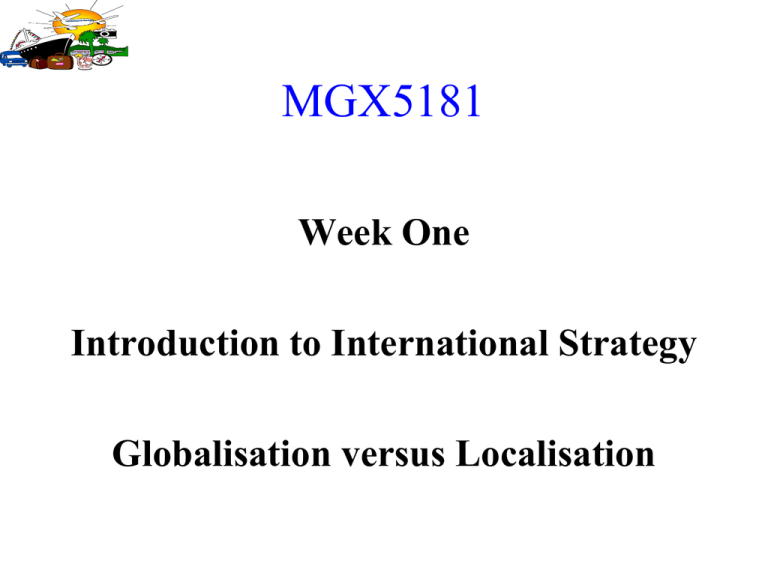
MGX5181 Week One Introduction to International Strategy Globalisation versus Localisation Unit Objectives • On completion of this unit students should be able to: Describe the concepts and use the tools for competitive analysis and strategic planning in the international environment. Formulate and implement strategies for SMEs and multinational organisations in a global setting. Identify and analyse the opportunities and dangers involved in international strategic management Evaluate the impact different types of foreign operations have on the internationalising organisation Week One Objectives • Define strategy, globalisation and a ‘global firm’ • Identify the forces pushing towards globalisation • Identify the forces pushing towards localisation • Discuss the global integration/local responsiveness grid What is Strategy? • Definitions vary between people and across cultures. • Theories vary across strategic issues so you need a toolbox of options rather than looking for the “one” best approach. • Maslow 1908-1970 “If the only tool you have is a hammer, you treat everything like a nail” Strategic Dimensions • There are three dimensions of strategy: • Strategic Process The manner in which strategies come about ie questions to ask: • How, who and when • How should strategy be made, implemented, changed and controlled, who is involved and when do the necessary activities take place? Strategic Dimensions • Strategic Content The product of a strategic process is referred to as the strategic content ie the what of strategy • What is and should be the strategy for this organisation or unit? • Strategic Context The circumstances under which both the strategic process and strategic content are determined is called the strategic context ie the where of strategy • Where as in which firm and which environment are the strategic process and strategic content embedded Evolution of international strategy • 1950s-1960s Multinational expansion through the establishment of miniature replica subsidiaries abroad. Predominance of multidomestic strategies, with largely autonomous foreign subsidiaries supplying local/regional markets. Limited global co-ordination or integration of geographically dispersed operations. Evolution of international strategy • 1970’s Multinationals in retreat: divestments, rationalisation and host country plant closures. • 1980’s Shift to co-ordinated and integrated global strategies by established MNEs (multinational enterprises); focus on global competitiveness and use of global scope as a competitive weapon in global industries involving plant specialisation and national interdependency Historically globalisation took place in 3 stages Global integration (Global) Internationalisation (Multinational) Export (Trade) 9 • 1990’s Evolution of international strategy Transition to global and transnational strategies. Business focus on developing core competences with outsourcing of other noncore activities. Development of global networks and strategic alliances which are both horizontal and vertical. Increasing emphasis on knowledge as an asset and early forms of learning organisation begin to develop • 2000’s The era of the “virtual” corporation and the intelligent organisation? 21st-century competitive landscape • The nature of competition in many of the world’s industries is changing • Conventional sources of competitive advantage – economies of scale and huge advertising budgets – are not so effective as they were in the 1900s • Rapid technological change • Pressure for innovation and knowledge management • Hypercompetition 11 Developing an International Perspective “Every man takes the limits of his own field of vision for the limits of the world” Arthur Schopenhauer 1788-1860 • When it comes to strategic perspectives, countries can differ in many ways eg Language, business culture, education, distribution, laws etc • The question is: how significant are these international differences? Developing an International Perspective • Another issue is impact of international linkages To what extent do events in one country have an impact on what happens in other countries? Countries linked closely together leads to international integration Countries with weak links leads to international fragmentation. The question for the strategist is how closely are they linked? – if fragmented then each country can be viewed separately if highly integrated the strategist must view all countries as part of the same system Globalisation versus localisation • Some strategists see countries becoming more similar and interrelated. • This development towards lower international variety and tighter linkages is referred to as the process of globalisation – leading eventually to a “nationless” world – a global convergence perspective. Globalisation forces IT and Communications Capital Flow Consumer Convergence Deregulation and Trade Agreements Trade Investments Globalisation Information People Cross-borders Innovation Cross-borders Sourcing and Production Cross-borders Marketing Cross-Cultural Management 15 Two dimensions of globalisation? Integration and Coordination • Optimise competitiveness by leveraging international, resource, assets and competencies leading to: • Differentiated advantage • Cost advantage • Speed advantage • Innovation advantage Traditional globalisation • Expand value adding activities • into countries in order to capture: •Market opportunities •Resources •Learning Spread risk Multinational Expansion 16 Global Convergence Perspective • Many examples of convergence: Clothing, TVs, vehicles, phones, music etc and many of the same companies seen around the world Global convergence driven by the ease, low cost and frequency of international communication, transport and travel. This has diminished the importance of distance. Focus is long term and on emerging global reality (Ohmae, 1990). Result is a “global village”, where individual firm leverage resources to gain scale economies through “standardisation” (Levitt, 1983) Global Convergence Perspective International integrated facilities provides centralisation. Firms look for most attractive locations for R&D, marketing, sales and procurement – aim is world-wide economies of scale. Buyers can shop at one global market, suppliers and competitors create global industries, resulting in companies coordinating their global strategies ie developing global strategic alignment Political Factors •WTO •EU •FDI Reduce trade barriers Technology Factors •Transport •Teleommunications •R&D •Manufacturing Social Factors Globalisation Favours standardisation and global branding Reduce the cost of coordination and increase economies of scale Competitive Factors •Multinational customers •Shorter cycles P. Lasserrre 2013 •Convergence of customers needs •Travel •TV •Movies Induce integration and coordination Divergence (localization) perspective • Other strategists suggest important international differences will not change easily. Therefore international variety might increase and international linkages loosen, referred to as “localization” • These strategists suggest you must be willing to adapt to complex variety and fragmentation that characterises our world. This is called an international diversity perspective. International Diversity Perspective • It is easier to see convergence however the actual level of international variety might be quite consistent. Why? Habits change slowly, and cultural norms and values are outright rigid (de Wit et al 2010) Renewed emphasis on local language, political systems diverse, legal differences etc. New developments and novel systems in nations creates international divergence (Dosi & Kogut, 1993). Cultural Factors •Attitudes and tastes •Behaviour •Social codes Reduce the benefits of standardisation Technical Factors •Standards •Spatial presence •Transporation •Languages Reduce the benefits of economies of scale, centralisation and standardisation Commercial Factors Localisation •Distribution networks •Customisation •Responsiveness Requires differentiated approaches to sales and marketing Legal Factors •Regulations •National security P. Lasserrre 2013 Limits free flow of people, goods, data, cash Imposes localisation constraints 22 Dealing with Convergence and Divergence • International organisations that can balance these two competing factors are called “transnationals” (Bartlett and Ghoshal, 1995) Are transnationals good? – well some types might not be: http://vimeo.com/53497863 • Strategists must wrestle with the paradox of globalisation (convergence) and localisation (divergence). Why companies globalise? • Increase size (V): capture market opportunities Customer Value (CV) • Increase size benefit from economies of scale (C) PROFIT • Get access to resources (S) • Get access to low cost labor and infrastructure (C) Price Costs Internal Costs (C) Supplies (S) Volume (V) • Get access to knowledge (CV and C) • Serve global customers (CV) • Reduce risks through geographic diversification 24 Global industries • A global industry is an industry in which firms can sustain competitive advantages only through: 25 A multi-market presence An integration and cross-borders coordination of their resources, assets and competencies in various components of the value chain Global industry • An industry is ‘global’ when: 26 Customers have similar demands for functionalities and design across countries Customers “behave” the same way across countries Products or services have a high proportion of standard components across countries Customers (or distributors) themselves operating in different countries and are buying centrally 26 Global industry • An industry is ‘global’ when: 27 Minimum economies of scale can only be achieved by serving multiple national markets The speed of introducing new products worldwide is important for competitiveness Experience gained in one country is transferable to others countries Competitors operate successfully in a “standardized” and “centralized” way across countries 27 Local industry • An industry is ‘local’ when Sales of products or services depend on cultural factors Pricing can be different from country to country (No arbitrage) The extent distribution channel management differ from country to country The extent business regulations and contexts differ from country to country requiring a high degree of local practices The extent products or services require a high degree of interaction with customers (customisation) Local customer interface is needed to operate 28 28 Global integration/local responsiveness grid • Two sets of forces described – globalisation and localisation – are shaping the competitive structure of industries worldwide. 29 The result is that companies need to configure their business systems worldwide with the correct balance of co-ordination, integration or decentralisation. • The global integration/local responsiveness grid is used for identifying the competitive requirements of an industry or a business segment and can assist companies in formulating business and country strategies. Degree of universality of product Factors limiting universality Examples Culture/habits Design taste • Fish sausage • Furniture • Root beer • Refrigerator • Boxer shorts • Processed food Language • Word processor • Computer • Rice cooker Size/package • Textile • Automobile (seat size) • Soft drinks Technical system User/ application • Colour TV (PAL system in European voltage) • Portable radio/cassette player (youths in US) None • Watch • Motorcycle • Petrochemical • White liqueur (young females products in Japan) • Piano • Money (capital market) Marketing concept Technology Product application Product concept Source: Ohmae Must modify locally Could be shared globally 30 Global integration/local responsiveness grid • The first two categories are easily defined and justified. Firstly, global forces are dominant and there are few advantages to push for localisation. • Examples include civil aircraft, microchips and baulk chemicals. In these industries, efficiency, speed and learning are prime competitive drivers. 31 Global integration/local responsiveness grid The second type is local forces, where flexibility and quick response to customer needs are the key determinants of competitive advantage. • Examples in this category include food retailing and consumer banking. 32 Global integration/local responsiveness grid • The final category is more complex and involves a mix of both global and local forces. Competitive advantage is achieved through a combination of global integration and rationalisation, as well a local responsiveness. • Many sectors, such as the automobile industry, find that this combination is required for maintaining an advantage in an increasingly competitive industry. 33 Competitive requirements HIGH Telecommunication Equipment Civil Aircraft Institutional Banking GLOBAL FORCES Bulk Chemicals Corporate Banking Automobiles Paint Package Tours Retail Banking LOW Catering LOW LOCAL FORCES HIGH 34 Competitive requirements within segments - Paint HIGH Marine Automotive Cars Aircraft GLOBAL FORCES Industrial Do it yourself LOW LOW LOCAL FORCES HIGH 35 Competitive requirements business functions HIGH Research Development Finance GLOBAL FORCES After Sales Services Components Sourcing Components Manufacturing Logistics Marketing Advertising Accounting Customers Services Sales LOW LOW LOCAL FORCES HIGH 36 Globalisation versus Localisation • Thinking about industries you know, what opportunities and threats does a trend to globalisation versus localisation provide? • Can these two trends be balanced? • What strategies can an individual firm use to take advantage of either trend? http://www.youtube.com/watch?feature=player_detailpage&v =R0W3Wi_mJ14 http://www.youtube.com/watch?feature=player_detailpage&v =12YDLZq8rT4 (first 18.23min only) Class discussion: What are the pros and cons of globalisation V localisation? What is the role of regionalisation? Terms • International company A business operating in more than one country. • A Multinational Company (MNC) A multinational company carries out one activity (e.g. manufacturing) or a component of the activity (e.g. manufacturing one sub-part only) of the value chain in one country which serves the company’s worldwide market. Consequently, a multinational’s operations are self contained in each country and are assessed on a country by country basis. • Multinational Enterprises (MNEs) are not true corporations eg accounting partnerships and Lloyd’s of London Terms • Multinational organisation (MNO) covers not-for-profit and profit seeking organisations. • Griffin and Pustay (2009) • Multidomestic company (MDC) is an organisation with multi-country affiliates each which formulates its own business strategy based on perceived market differences. • Ball et al (2010) Terms • Global firm can be defined as a company that operates in the main markets of the world in an integrated and co-ordinated way. Integration, co-ordination and rationalisation are the key terms usually applied to a firm’s progression from a multinational approach to international operations to a global approach. Refers to more than just markets and is used to indicate the potentially global scope of all of an organisation’s business operations and its ability to compete on a global scale (Yip,1992) • Transnational 40 A globally networked company aiming for benefits of globalisation and localisation
